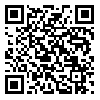دوره 16، شماره 1 - ( 10-1397 )
جلد 16 شماره 1 صفحات 91-81 |
برگشت به فهرست نسخه ها
چکیده: (3718 مشاهده)
Introduction: Workload is one of the most important occupational factors of anxiety. The present study aimed to investigate workload and its associated factors among nurses working in teaching hospitals of Shiraz University of Medical Sciences in Iran.
Methods: This cross-sectional descriptive-analytic study was conducted in 2017. A total of 340 nurses from the hospitals were selected using the stratified random sampling method, and finally 312 individuals were recruited in this study. The data collection instrument included the National Aeronautics and Space Administration Task Load Index. The data were also analyzed through descriptive indices as well as t-test, analysis of variance, Pearson’s correlation coefficient, and multiple linear regression. SPSS Software, Version 16, was used to analyze the data at a significance level of 0.05 (α=0.05).
Results: The mean score of workload was 73.47±21.81. The mean scores of the effort rate (79.09±21.81) and frustration and failure level (59.51±30.76) also received the highest and the lowest values, respectively. Moreover, statistically significant relationships were observed between level of education (p=0.03), employment relationships (p=0.001), number of patients under the nurses’ monitoring per work shift, and the mean score assigned to workload among nurses (p=0.04, r=0.117).
Conclusion: The workload among nurses examined in this study was reported at a high level. Therefore, managers should implement programs such as motivational incentives and welfare services to moderate the workload in nursing.
Methods: This cross-sectional descriptive-analytic study was conducted in 2017. A total of 340 nurses from the hospitals were selected using the stratified random sampling method, and finally 312 individuals were recruited in this study. The data collection instrument included the National Aeronautics and Space Administration Task Load Index. The data were also analyzed through descriptive indices as well as t-test, analysis of variance, Pearson’s correlation coefficient, and multiple linear regression. SPSS Software, Version 16, was used to analyze the data at a significance level of 0.05 (α=0.05).
Results: The mean score of workload was 73.47±21.81. The mean scores of the effort rate (79.09±21.81) and frustration and failure level (59.51±30.76) also received the highest and the lowest values, respectively. Moreover, statistically significant relationships were observed between level of education (p=0.03), employment relationships (p=0.001), number of patients under the nurses’ monitoring per work shift, and the mean score assigned to workload among nurses (p=0.04, r=0.117).
Conclusion: The workload among nurses examined in this study was reported at a high level. Therefore, managers should implement programs such as motivational incentives and welfare services to moderate the workload in nursing.
| بازنشر اطلاعات | |
 |
این مقاله تحت شرایط Creative Commons Attribution-NonCommercial 4.0 International License قابل بازنشر است. |

